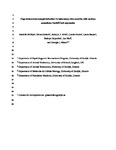Cage-induced stereotypic behaviour in laboratory mice covaries with nucleus accumbens FosB/ΔFosB expression.
| dc.contributor.author | Phillips, D | en |
| dc.contributor.author | Choleris, E | en |
| dc.contributor.author | Ervin, KSJ | en |
| dc.contributor.author | Fureix, C | en |
| dc.contributor.author | Harper, L | en |
| dc.contributor.author | Reynolds, K | en |
| dc.contributor.author | Niel, L | en |
| dc.contributor.author | Mason, GJ | en |
| dc.date.accessioned | 2017-12-12T17:56:10Z | |
| dc.date.available | 2017-12-12T17:56:10Z | |
| dc.date.issued | 2016-03-15 | en |
| dc.identifier.uri | http://hdl.handle.net/10026.1/10412 | |
| dc.description.abstract |
Stereotypic behaviour (SB) occurs in certain human disorders (e.g. autism), and animals treated with stimulants or raised in impoverished conditions, including laboratory mice in standard cages. Dysfunctional cortico-basal ganglia pathways have been implicated in these examples, but for cage-induced forms of SB, the relative roles of ventral versus dorsal striatum had not been fully ascertained. Here, we used immunohistochemical staining of FosB and ΔFosB to assess long-term activation within the nucleus accumbens and caudate-putamen of C57BL/6 mice. Housed in typical laboratory cages, these mice spontaneously developed different degrees of route-tracing, bar-mouthing and other forms of SB (spending 0% to over 50% of their active time budgets in this behaviour). The most highly stereotypic mice showed the most elevated FosB/ΔFosB activity in the nucleus accumbens. No such patterns occurred in the caudate-putamen. The cage-induced SB common in standard-housed mice thus involves elevated activity within the ventral striatum, suggesting an aetiology closer to compulsive gambling, eating and drug-seeking than to classic amphetamine stereotypies and other behaviours induced by motor loop over-activation. | en |
| dc.format.extent | 238 - 242 | en |
| dc.language | eng | en |
| dc.language.iso | eng | en |
| dc.subject | Abnormal repetitive behaviour | en |
| dc.subject | Caudate-putamen | en |
| dc.subject | Nucleus accumbens | en |
| dc.subject | Stereotypic behaviour | en |
| dc.subject | Stereotypy | en |
| dc.subject | Striatum | en |
| dc.subject | Transcription factor | en |
| dc.subject | ΔFosB | en |
| dc.subject | Animals | en |
| dc.subject | Cell Count | en |
| dc.subject | Female | en |
| dc.subject | Housing, Animal | en |
| dc.subject | Immunohistochemistry | en |
| dc.subject | Mice, Inbred C57BL | en |
| dc.subject | Mice, Inbred DBA | en |
| dc.subject | Motor Activity | en |
| dc.subject | Neurons | en |
| dc.subject | Nucleus Accumbens | en |
| dc.subject | Proto-Oncogene Proteins c-fos | en |
| dc.subject | Species Specificity | en |
| dc.subject | Stereotyped Behavior | en |
| dc.title | Cage-induced stereotypic behaviour in laboratory mice covaries with nucleus accumbens FosB/ΔFosB expression. | en |
| dc.type | Journal Article | |
| plymouth.author-url | https://www.ncbi.nlm.nih.gov/pubmed/26731014 | en |
| plymouth.volume | 301 | en |
| plymouth.publication-status | Published | en |
| plymouth.journal | Behav Brain Res | en |
| dc.identifier.doi | 10.1016/j.bbr.2015.12.035 | en |
| plymouth.organisational-group | /Plymouth | |
| plymouth.organisational-group | /Plymouth/Faculty of Science and Engineering | |
| plymouth.organisational-group | /Plymouth/REF 2021 Researchers by UoA | |
| plymouth.organisational-group | /Plymouth/REF 2021 Researchers by UoA/UoA04 Psychology, Psychiatry and Neuroscience | |
| dc.publisher.place | Netherlands | en |
| dcterms.dateAccepted | 2015-12-20 | en |
| dc.identifier.eissn | 1872-7549 | en |
| dc.rights.embargoperiod | Not known | en |
| rioxxterms.versionofrecord | 10.1016/j.bbr.2015.12.035 | en |
| rioxxterms.licenseref.uri | http://www.rioxx.net/licenses/all-rights-reserved | en |
| rioxxterms.licenseref.startdate | 2016-03-15 | en |
| rioxxterms.type | Journal Article/Review | en |


